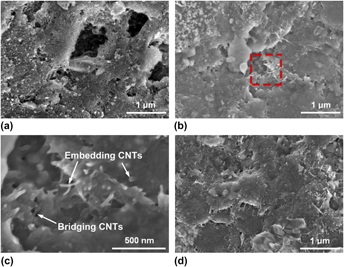Crossref Citations
This article has been cited by the following publications. This list is generated based on data provided by
Crossref.
He, Beibei
Chang, Kun
Wu, Wenheng
and
Zhang, Cailin
2017.
The formation mechanism of TiC reinforcement and improved tensile strength in additive manufactured Ti matrix nanocomposite.
Vacuum,
Vol. 143,
Issue. ,
p.
23.
Lehmhus, Dirk
Busse, Matthias
von Hehl, Axel
Jägle, Eric
Pantelakis, S.
and
Koubias, S.
2018.
State of the Art and Emerging Trends in Additive Manufacturing: From Multi-Material processes to 3D printed Electronics.
MATEC Web of Conferences,
Vol. 188,
Issue. ,
p.
03013.
Radhamani, A.V.
Lau, Hon Chung
and
Ramakrishna, S.
2018.
CNT-reinforced metal and steel nanocomposites: A comprehensive assessment of progress and future directions.
Composites Part A: Applied Science and Manufacturing,
Vol. 114,
Issue. ,
p.
170.
Attar, Hooyar
Ehtemam-Haghighi, Shima
Kent, Damon
and
Dargusch, Matthew S.
2018.
Recent developments and opportunities in additive manufacturing of titanium-based matrix composites: A review.
International Journal of Machine Tools and Manufacture,
Vol. 133,
Issue. ,
p.
85.
Zhang, Yaran
Cai, Qi
Liu, Yongchang
Guo, Qianying
and
Li, Huijun
2019.
Precipitation of Carbides and Dissolution of Widmanstätten Structure for Enhanced Hardness in Ti2AlNb-Based Alloys.
Journal of Materials Engineering and Performance,
Vol. 28,
Issue. 3,
p.
1892.
Hassanzadeh-Aghdam, Mohammad Kazem
Mahmoodi, Mohammad Javad
Ansari, Reza
and
Mehdipour, Hadi
2019.
Effects of adding CNTs on the thermo-mechanical characteristics of hybrid titanium nanocomposites.
Mechanics of Materials,
Vol. 131,
Issue. ,
p.
121.
Nandy, Jyotirmoy
Sarangi, Hrushikesh
and
Sahoo, Seshadev
2019.
A Review on Direct Metal Laser Sintering: Process Features and Microstructure Modeling.
Lasers in Manufacturing and Materials Processing,
Vol. 6,
Issue. 3,
p.
280.
Ardila-Rodríguez, Laura Angélica
Medeiros, Bruno Bellini
de Oliveira, Aline Capella
and
Travessa, Dilermando Nagle
2019.
Al/MWCNT Composite Layer Deposition on Aluminum Alloy Substrate by Selective Laser Melting and Flame Spray.
Journal of Manufacturing Science and Engineering,
Vol. 141,
Issue. 10,
Ardila-Rodríguez, L.A.
Menezes, B.R.C.
Pereira, L.A.
Takahashi, R.J.
Oliveira, A.C.
and
Travessa, D.N.
2019.
Surface modification of aluminum alloys with carbon nanotubes by laser surface melting.
Surface and Coatings Technology,
Vol. 377,
Issue. ,
p.
124930.
Wang, Shujun
and
Gao, Lihong
2019.
Industrial Applications of Nanomaterials.
p.
181.
Fereiduni, Eskandar
Ghasemi, Ali
and
Elbestawi, Mohamed
2020.
Selective Laser Melting of Aluminum and Titanium Matrix Composites: Recent Progress and Potential Applications in the Aerospace Industry.
Aerospace,
Vol. 7,
Issue. 6,
p.
77.
Singh, N.
Hameed, P.
Ummethala, R.
Manivasagam, G.
Prashanth, K.G.
and
Eckert, J.
2020.
Selective laser manufacturing of Ti-based alloys and composites: impact of process parameters, application trends, and future prospects.
Materials Today Advances,
Vol. 8,
Issue. ,
p.
100097.
Afrouzian, Ali
Avila, Jose D.
and
Bandyopadhyay, Amit
2021.
Biotribocorrosion of 3D-printed silica-coated Ti6Al4V for load-bearing implants.
Journal of Materials Research,
Vol. 36,
Issue. 19,
p.
3974.
Anand, Mukul
and
Das, Alok Kumar
2021.
Issues in fabrication of 3D components through DMLS Technique: A review.
Optics & Laser Technology,
Vol. 139,
Issue. ,
p.
106914.
DeMartino, Anthony
Ansell, Troy Y.
and
Nieto, Andy
2022.
Effects of Laser Energy Density on Carbon‐Nanotube‐Reinforced Titanium Composites Printed via Selective Laser Melting.
Advanced Engineering Materials,
Vol. 24,
Issue. 2,
Demianenko, E. M.
Terets, M. I.
Ushakova, L. M.
Zhuravskyi, S. V.
Sementsov, Yu. I.
Lobanov, V. V.
Filonenko, O. V.
Kuts, V. S.
Grebenyuk, A. G.
and
Kartel, M. T.
2022.
A theoretical study on the effect of heteroatoms (N, B, Si) on the interaction of aluminum clusters with a carbon graphene-like plane.
Himia, Fizika ta Tehnologia Poverhni,
Vol. 13,
Issue. 4,
p.
391.
Nieto, Andy
Vukkum, Venkata Bhuvaneswari
Jalagam, Prajna
Nema, Kanishq
Budan, Justin
Gupta, Rajeev Kumar
and
Ansell, Troy Y.
2022.
3D printed carbon nanotube reinforced stainless steel via selective laser melting.
MRS Communications,
Vol. 12,
Issue. 5,
p.
578.
Demianenko, E. M.
Terets, M. I.
Zhuravskyi, S. V.
Sementsov, Yu. I.
Lobanov, V. V.
Kuts, V. S.
Grebenyuk, A. G.
and
Kartel, M. T.
2022.
Theoretical simulation of the interaction of Fe2 cluster with A N, B, Si-containing carbon graphene-like plane.
SURFACE,
Vol. 14(29),
Issue. ,
p.
37.
Awotunde, Mary A.
Adegbenjo, Adewale O.
Ajide, Olusegun O.
and
Olubambi, Peter A.
2023.
Influence of Ti/TiC interface and its site of formation on the properties of powder metallurgically fabricated Ti-based composites reinforced with carbonaceous materials: A review.
Critical Reviews in Solid State and Materials Sciences,
Vol. 48,
Issue. 6,
p.
643.
Thakur, Arvind Kumar
and
Kumar, Dinesh
2023.
SIMULATION-BASED FINITE ELEMENT MODELING AND CHARACTERIZATION OF CNT REINFORCED Ti-6Al-7Nb NANOCOMPOSITE
.
Composites: Mechanics, Computations, Applications: An International Journal,
Vol. 14,
Issue. 4,
p.
49.



